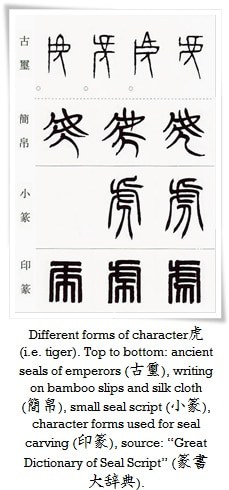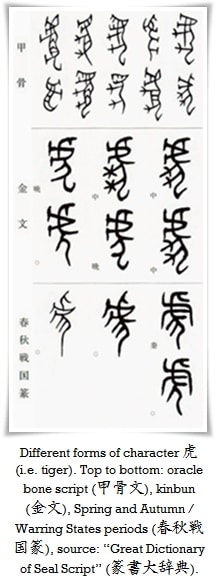The origins of seal script (篆書, tensho) reach deep into the history of China; all the way to the end of Xia dynasty (夏朝, 2070 B.C. – 1600 B.C.) – the first historically verified Chinese dynasty. Seal script is a term that is used for both great seal script (大篆, daiten) and small seal script (小篆, shouten).
Although oracle bone script (甲骨文, koukotsubun) is often considered to be a separate script, one could risk a statement that great seal script, in a wide sense of the definition, embraces not only kinbun (金文, i.e. bronze vessel inscriptions) but also oracle bone script or, in the least, that both styles have existed in parallel for hundreds of years, and the characters “篆書” clearly suggest “incised text”.
Since oracle bone script was engraved with a knife in animal bones, and kinbun in clay with a stylus prior to casting, or, in later periods, carved on stones (the earliest text carved in stones ever found was 石鼓文, lit. “text on stone drums”, Japanese reading: sekkobun; dating of which is debatable and spans between late Western Zhou (1046 – 771 B.C.), i.e. 8th century B.C., to late Warring States period (戰國時代, 475 – 221 B.C.) i.e. late 3rd century B.C., it would mean that both scripts were incised.
Radical differences in appearance of both kinbun and oracle bone script were caused mainly by the density of the surfaces used for carving (bones versus clay). This is one of the reasons why kinbun is more ornamental and complex, and oracle bone script simple and raw. Characters of both scripts are usually oblong, and abstract forms appear along pictographic ones.
Small seal script is a name used for characters after their formal unification in 221 B.C. by the highly influential Prime Minister Li Si (李斯) of the Qin dynasty of China (秦朝 221 – 206 B.C).
Nonetheless, due to outstanding features of oracle bone script, as well as great and small seal scripts in strict sense, they shall be discussed separately.


